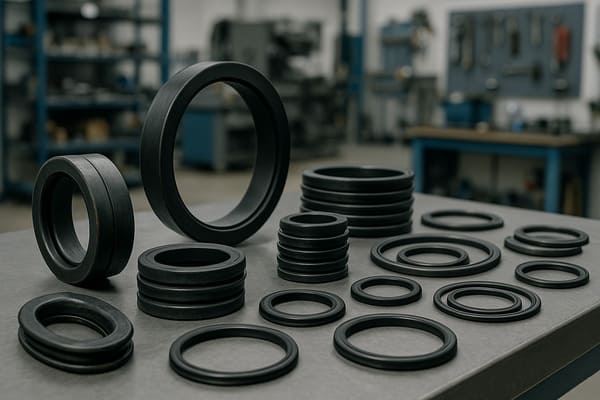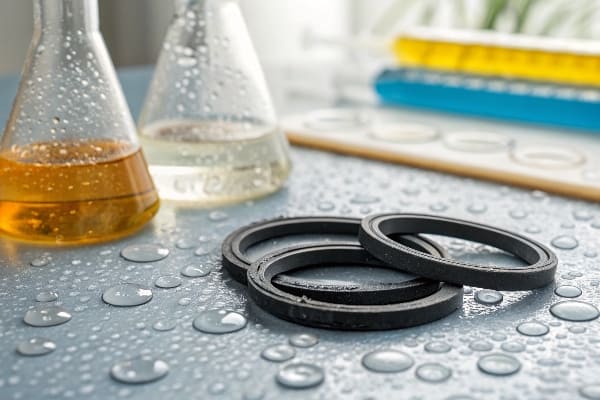Are you looking for the best rubber materials to resist acid exposure? Acid resistance is a key property in many industrial applications. Let's explore which rubber types offer the best protection against acidic substances.
The best acid-resistant rubbers are EPDM, Viton (FKM), and nitrile rubber (NBR). These materials offer excellent resistance to a wide range of acids, including sulfuric, hydrochloric, and acetic acids.

Choosing the right rubber material for acid resistance depends on the specific type of acid and the application environment. Let’s dive deeper into the properties of the most acid-resistant rubber types and their best uses.
What Is Acid Resistance in Rubber?
Are you wondering what makes rubber acid-resistant? Understanding the chemical properties of acid-resistant rubber will help you choose the best material for your application.
Acid resistance in rubber refers to the material's ability to withstand prolonged exposure to acidic substances without degrading. Acid-resistant rubber prevents deterioration, leaks, and failures in harsh chemical environments.
Acid resistance in rubber is determined by the material's molecular structure, which must be able to resist the corrosive properties of acids. When rubber is exposed to acids, it can swell, soften, crack, or degrade depending on the type and concentration of the acid.
Rubbers with high acid resistance1 are engineered to withstand prolonged exposure to various acids, such as sulfuric acid, hydrochloric acid, and acetic acid. These rubbers are typically used in environments where rubber components like seals, gaskets, hoses, and O-rings come into contact with acids during manufacturing processes, chemical processing, or industrial applications.
The choice of acid-resistant rubber2 depends on several factors, including the concentration of the acid, temperature, and the type of chemical exposure. Some rubbers are more resistant to certain types of acids than others, making it important to select the right material for your specific needs.
| Rubber Type | Acid Resistance | Ideal Applications |
|---|---|---|
| EPDM3 | Excellent | Seals, gaskets, hoses |
| Viton (FKM) | Very good | Seals, valves, gaskets |
| Nitrile (NBR) | Good | Fuel systems, general sealing |
✅ Why it matters:
Choosing the right rubber with good acid resistance helps prevent material breakdown, ensures the longevity of components, and maintains the integrity of your manufacturing processes.
Best Rubbers for Acid Resistance
Wondering which rubber materials offer the best acid resistance? Let’s look at the top rubber types that provide excellent protection against acids.
EPDM, Viton, and nitrile rubber are the best options for acid resistance. Each type is suited for different applications depending on the specific acid exposure.

When selecting rubber for acid resistance, there are a few key materials to consider, each offering distinct benefits depending on the application:
1. **EPDM Rubber
EPDM (Ethylene Propylene Diene Monomer) rubber is highly resistant to a wide range of acids, including sulfuric acid, hydrochloric acid, and acetic acid. It is often used in sealing applications for equipment that comes into contact with these acids. EPDM’s resistance to weathering, ozone, and aging also makes it ideal for outdoor applications where it may face prolonged exposure to acids and environmental factors.
- Best For: General sealing applications, hoses, gaskets, and pumps exposed to acids.
- Limitations: Not suitable for very high temperatures or oils.
2. Viton (FKM) Rubber4
Viton, a fluoroelastomer, is one of the best rubbers for high-temperature and aggressive acid resistance. It can handle concentrated acids, including sulfuric acid and hydrochloric acid, even at elevated temperatures. Viton is often used in chemical processing, aerospace, and automotive industries where high resistance to acid exposure is critical.
- Best For: High-temperature seals, valves, gaskets, and chemical processing equipment.
- Limitations: More expensive than other rubbers.
3. Nitrile Rubber (NBR)5
Nitrile rubber is commonly used for its oil and fuel resistance, but it also provides moderate resistance to certain acids like sulfuric acid. Nitrile is an affordable option for general sealing applications in industries where acid exposure is intermittent or not highly concentrated.
- Best For: General sealing applications in low-concentration acid environments.
- Limitations: Not ideal for strong or concentrated acids over time.
| Rubber Type | Acid Resistance | Best Application | Temperature Range |
|---|---|---|---|
| EPDM | Excellent | Seals, hoses, gaskets | -50°C to +150°C |
| Viton (FKM) | Very good | High-temp seals, valves | -20°C to +250°C |
| Nitrile (NBR) | Good | General sealing | -30°C to +100°C |
✅ Why it matters:
Each type of rubber offers different levels of protection against acids. Choosing the right material ensures long-term reliability and protection against chemical degradation.
How to Choose the Right Rubber for Acid Resistance?
Wondering how to choose the right rubber for acid exposure? Let’s break down the most important factors to consider when selecting acid-resistant rubber.
Consider factors like acid concentration, temperature, and the type of application to select the right rubber material for optimal acid resistance.

When choosing rubber for acid resistance, consider the following factors to ensure durability and effectiveness:
- Acid Concentration: Higher concentrations of acid require rubbers with superior chemical resistance like Viton. For lower concentrations, EPDM can provide sufficient protection.
- Temperature: Some rubbers, such as Viton, perform well at high temperatures, while EPDM is best for moderate temperature ranges. For high-heat applications, select a rubber like Viton.
- Exposure Duration: Continuous exposure to acids requires rubbers with long-term chemical resistance. EPDM and Viton are better for extended acid exposure6 than nitrile rubber.
- Application Type: Depending on whether you need seals, gaskets, or hoses, choose the right rubber type to match the mechanical stresses and exposure conditions.
Key Factors to Consider When Choosing Rubber for Acid Resistance:
| Factor | Best Rubber Choices | Key Considerations |
|---|---|---|
| Acid Concentration | EPDM, Viton (FKM) | Higher concentrations need Viton |
| Temperature | Viton (FKM), EPDM | Viton for high-temperature tolerance |
| Exposure Duration | EPDM, Viton (FKM) | Longer exposure needs more resistant materials |
| Application Type | EPDM, Viton (FKM), Nitrile | Choose based on specific component needs |
✅ Why it matters:
By carefully selecting the right rubber material based on these factors, you can ensure your components stand up to acid exposure without premature degradation.
Conclusion
When selecting rubber for acid-resistant applications, materials like EPDM, Viton, and nitrile rubber offer varying levels of protection against acids. EPDM and Viton are best for stronger acids or higher temperatures, while nitrile is more suited for lower concentrations. By considering factors like acid concentration, temperature, and the type of exposure, you can ensure the longevity and reliability of your rubber components.
🚀 Need Custom Rubber Solutions for Your Acid-Resistant Applications?
Contact Julong Rubber today or Request a Custom Quote for high-quality rubber components tailored to your specifications!
Or reach out to us directly via WhatsApp:
Understanding acid resistance in rubber is crucial for selecting the right materials for industrial applications, ensuring durability and safety. ↩
Explore the best types of acid-resistant rubber to make informed choices for your manufacturing needs, enhancing performance and longevity. ↩
Learn about EPDM rubber's properties and applications to see how it can benefit your projects, especially in acid exposure environments. ↩
Discover why Viton is preferred in high-temperature applications, especially in chemical processing and aerospace industries. ↩
Learn about the limitations of Nitrile Rubber in acid environments and its suitability for general sealing applications. ↩
Discover the impact of acid exposure on rubber materials and how to choose the right type for your needs. ↩








